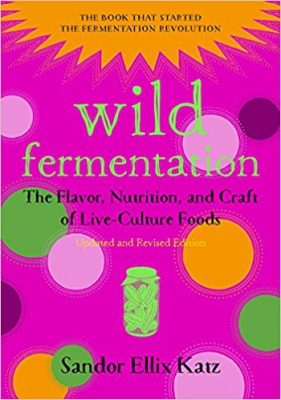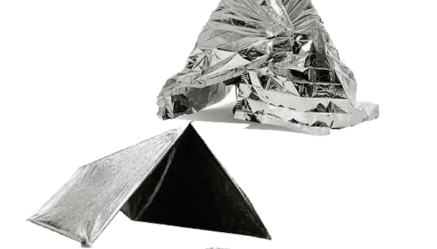This site contains affiliate links. As an Amazon Associate, I earn a commission from qualifying purchases at no extra cost to you. Full Disclosure Here.
Sandor Ellix Katz is the first introduction many people had to the world of fermenting. Fermentation is the process of allowing certain bacteria to transform our food– which makes it more nutritious and preserves it. In the prepper world, fermentation is an under-utilized skill. It can help solve many of our problems, but few know where to start with it. So, we need to talk about the ultimate beginner’s fermentation book.
Katz’s second book, the Art of Fermentation, is the top recommendation on my list of the best books on fermentation. It’s thorough, informed by science, clear, and packed with interesting recipes. It became a New York Times’ Best Seller. So why am I not reviewing it?
The problem is that the Art of Fermentation is a little intimidating. And Katz’s first book Wild Fermentation, while less informative, has a simple, free-spirited style that kick-started the modern fermentation craze in the first place. When first published in 2002 it exploded into the wider culture, paving the way for other fermentation books.
The 2nd edition, which I’ll be focusing on, was published in 2016, long after Katz’s rise to fame. It features new recipes and new details. It even indicates to the reader where the Art of Fermentation offers more technical information, if you wish to explore it. Ultimately, Wild Fermentation is the best fermentation book for beginners and will take you from sauerkraut to kombucha right quick.
Fermentation Theory
Wild Fermentation does have scientific information explaining the benefits of fermentation; its just not as detailed as in the Art of Fermentation. But just from this book, the advantage of fermentation for preppers is clear: when you have limited food you want to make the most of the nutrition it can provide you. Fermentation makes a food’s nutrients more available for your body.
And, of course, preppers want to be able to store their food for as long as possible. Katz points out that fermented vegetables are safer to store than raw vegetables, and no ferment requires refrigeration to keep from spoiling, although it can help, especially when the flavors become too strong.
After the first few chapters on fermentation theory, Katz will have drawn you in to try your first ferment.
Where the Beginner Should Begin: Sauerkraut
The best ferment to try first is sauerkraut– the first recipe in Wild Fermentation. Katz’s sauerkraut is so easy you can’t really call it his. You take a garden-fresh cabbage, rinse it in non-chlorinated water, chop it up thinly, mix it with salt (non-iodized is best), and squeeze it in your bare hands.
When the first drops of cabbage juice start to form you’ll know you’re getting somewhere. Eventually, the juices will pour out like from a soaked hand-towel. It’s a rewarding process for the beginner, especially if you’re the kind of person who likes kneading bread or making something with your hands.
All that’s left to do is pack the cabbage into a glass jar, cover it with it’s own liquid, remove all the air you can, and close the lid. You can taste it immediately (and you’ll want to, the air will be thick with an enchanting smell) and every 24 hours or so thereafter.
The idea, Katz explains, is both to relieve the pressure building in the jar, and to see how fermented you like your sauerkraut. When it gets too strong for your taste, pop it in the fridge. Sauerkraut is absurdly difficult to get wrong.
The “Wild” Part of Wild Fermentation
Wild Fermentation also has recipes on the wilder side, from all kinds of cultures. The human cultures include those from Ethiopia, Indonesia, Germany, Lebanon, Japan, India, Guyana, and more. But the recipes are still explained simply and don’t require fancy equipment –except for some alcohols.
Last fall I had plenty of kale so I decided to try gundruk, a ferment from the Himalayas that you can make with any brassica. The process was much the same as that for sauerkraut, but it called for drying periods and a longer fermentation time. The result was not to my liking. To be fair, Katz did warn that gundruk was strong and generally put in soups, while I chewed it by itself. And perhaps I did something wrong.
But, like when trying any new foods, you have to expect that not everything fermented will taste good to you. Plenty of them are acquired tastes. And some of the recipe’s instructions might be outside of your comfort zone. For example, Katz tells the reader to get some friends to help you chew corn, and spit it out, to start the fermentation process! Even though you boil it, I’ll keep my spit to myself, thanks.
My biggest successes with Wild Fermentation have been at the breakfast table. First was Alaskan Frontier Sourdough Hotcakes, a ferment that can handle the cool climate. The recipe has a trick to keep the sourdough a little sweeter than normal. As an oatmeal fan, I was also particularly pleased with the creamy results from Katz’s Oat Porridge.
You’ll also find the book has recipes for cheese, yogurt, alcohol, kimchi, kvass, vinegar, bread, pickles, miso, and more.
Personal Life and Health
Wild Fermentation offers more than recipes and science. Fermentation was a personal journey for Katz, and so he talks about his struggles with AIDS and the challenges of facing his mother’s death in the book. He also makes it clear that he leads the kind of commune life that may repel many on the more conservative side.
A whole other segment of people will instead be concerned by Katz’s thoughts on health. Yes, fermentation makes nutrients more available in most foods, and regularly eating these recipes, most of which are vegetable-based, is certainly a step-up from the diet most Americans follow. But, Katz’s personal feeling is that it is a combination of daily anti-retroviral medications and fermented foods that make him healthy.
While Katz makes it clear that fermented foods aren’t a cure for anything, he fails to recognize that they also aren’t a treatment for anything. He argues, point blank, that fermented foods “can improve digestion, immune function, mental health, and possibly much more.” While there are studies looking into these claims, you shouldn’t rely on fermented foods to work wonders for you just yet.
Regardless of Katz’s lifestyle choices and personal opinions on health, you can still find everything you need to start fermenting in this amazing book.
Other Resources
If you’ve caught the fermentation bug, you can find our recommendations for the best books here. We also have a handy guide on fermentation vessels. If you want more from Katz, you should check out his Wild Fermentation website, or follow him on Instagram @sandorkraut.
If you enjoyed this article, consider following our Facebook page.















